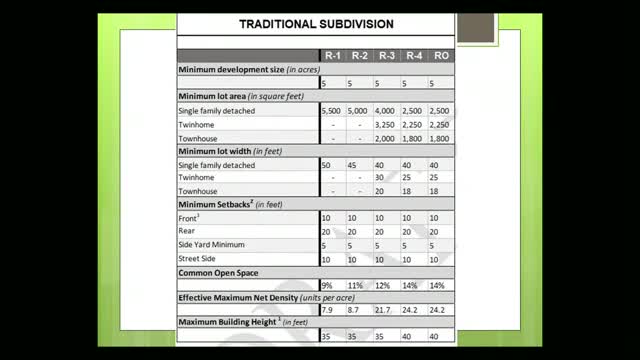City plans bold conservation strategy for new subdivisions
August 15, 2024 | Moscow City, Latah County, Idaho
This article was created by AI summarizing key points discussed. AI makes mistakes, so for full details and context, please refer to the video of the full meeting. Please report any errors so we can fix them. Report an error »

In a recent government meeting, officials discussed proposed changes to subdivision regulations aimed at balancing development with environmental preservation. The meeting highlighted two primary subdivision options: traditional and conservation subdivisions.
The traditional subdivision option allows for a minimum lot size of 5,500 square feet, significantly lower than the current standard of 9,600 square feet. This change is intended to facilitate higher density development while maintaining necessary open spaces. The conservation subdivision option, on the other hand, emphasizes the preservation of sensitive areas such as floodplains, wetlands, and wildlife habitats. This approach allows for smaller lot sizes in exchange for increased open space, which is crucial as the city expands, particularly around areas like Paradise Creek.
Commission members expressed a strong desire to prioritize the preservation of natural areas, even in cases where no sensitive land is identified on a property. The proposed regulations would still permit the use of conservation subdivisions to maintain open space, reflecting a commitment to environmental stewardship.
The meeting also touched on the rationale behind differing park space requirements based on population density in various zoning areas. Officials explained that denser zones require more park space due to a higher number of residents, while less dense areas, such as those designated R1, necessitate less parkland.
Concerns were raised about the notification process for appeals related to zoning decisions. Officials clarified that applicants are directly contacted to ensure they receive timely notifications, which is crucial for maintaining transparency and accountability in the zoning process.
Additionally, the maintenance of stormwater detention ponds was discussed, with officials noting that while developers are responsible for their creation, the city typically oversees their upkeep, depending on whether they are part of a public subdivision or private property.
Overall, the meeting underscored the city's commitment to sustainable development practices while addressing the complexities of urban growth and environmental conservation. The proposed ordinance will be forwarded to the city council for further consideration following public hearings and discussions.
The traditional subdivision option allows for a minimum lot size of 5,500 square feet, significantly lower than the current standard of 9,600 square feet. This change is intended to facilitate higher density development while maintaining necessary open spaces. The conservation subdivision option, on the other hand, emphasizes the preservation of sensitive areas such as floodplains, wetlands, and wildlife habitats. This approach allows for smaller lot sizes in exchange for increased open space, which is crucial as the city expands, particularly around areas like Paradise Creek.
Commission members expressed a strong desire to prioritize the preservation of natural areas, even in cases where no sensitive land is identified on a property. The proposed regulations would still permit the use of conservation subdivisions to maintain open space, reflecting a commitment to environmental stewardship.
The meeting also touched on the rationale behind differing park space requirements based on population density in various zoning areas. Officials explained that denser zones require more park space due to a higher number of residents, while less dense areas, such as those designated R1, necessitate less parkland.
Concerns were raised about the notification process for appeals related to zoning decisions. Officials clarified that applicants are directly contacted to ensure they receive timely notifications, which is crucial for maintaining transparency and accountability in the zoning process.
Additionally, the maintenance of stormwater detention ponds was discussed, with officials noting that while developers are responsible for their creation, the city typically oversees their upkeep, depending on whether they are part of a public subdivision or private property.
Overall, the meeting underscored the city's commitment to sustainable development practices while addressing the complexities of urban growth and environmental conservation. The proposed ordinance will be forwarded to the city council for further consideration following public hearings and discussions.
View full meeting
This article is based on a recent meeting—watch the full video and explore the complete transcript for deeper insights into the discussion.
View full meeting